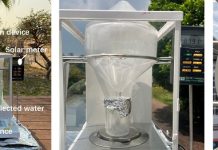
A scientist at the Institute for Molecular Science has made a breakthrough in understanding why water slows down when it’s supercooled—cooled below its freezing point without turning into ice.
This discovery is crucial for grasping the glass transition in liquids, a process where liquids become glass-like solids.
The study, titled “Unraveling the Dynamic Slowdown in Supercooled Water: The Role of Dynamic Disorder in Jump Motions,” has been published in The Journal of Chemical Physics. It delves into the microscopic mechanisms that control how water behaves when supercooled.
When water is supercooled, it slows down significantly, but without any visible structural changes.
The scientist used molecular dynamics simulations to study the jump dynamics of water molecules, which are tiny movements crucial for changing the structure of water. These simulations revealed that as water gets colder, these jumps don’t follow the expected patterns, due to something called dynamic disorder.
Dynamic disorder is the competition between slower processes and the jump movements of molecules. The researcher found that the movement of the fourth-nearest oxygen atom to a jumping molecule is a slow process that competes with these jumps at lower temperatures.
This movement happens in a fluctuating environment beyond the first layer of water molecules surrounding the jumping molecule and significantly impacts the jump dynamics.
As the temperature drops, water molecules move more slowly and less consistently. They get trapped in stable, low-density regions. With further cooling, the interactions between molecules become more cooperative, making the jump dynamics more complex and multi-dimensional.
This research advances our understanding of supercooled water and lays the groundwork for future studies on how liquids transition to a glassy state. Glass transition processes are important for many applications, from materials science to everyday products.
The methods developed in this study can also help us understand how the slow movement of various materials leads to glass transitions. Additionally, this research opens the door for future studies on the complex dynamics in other systems, such as proteins.
In summary, this study provides new insights into why water slows down at low temperatures and highlights the importance of dynamic disorder in this process.
It paves the way for further research into the behavior of supercooled liquids and their transition to glassy states, which could have wide-ranging implications in science and industry.



